Giving Thanks
Posted on Tuesday, November 10, 2020 · Leave a Comment
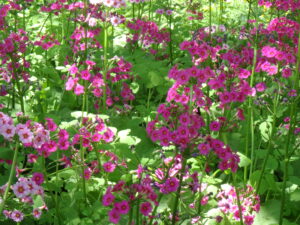
Candelabra primroses delight me each June
I think it’s important to take time to count my blessings. I try to take time each day to reflect on how grateful I am for living the life I do. And on a sunny afternoon near Thanksgiving I like to sit outside and reflect on everything I have to be grateful for. Here are some thoughts about my life, and how gardening helps to make my life full, satisfying – and rich in flowers and vegetables.
I am grateful to have a loving family and wonderful friends. On July 1 of this year Cindy Heath and I got married, after 11 years of partnership. Our family and friends attended via Zoom. Cindy is a wonderful person, an accomplished fiber artist and a terrific gardener. Not only that, she loves to weed! The gardens here in Cornish Flat have never been so well tended. I am so grateful to have her in my life.
I am very pleased to have a newspaper column that has kept me writing and learning for 22 years. On November 11, 1998 my first gardening column appeared in the Valley News of West Lebanon, NH. In that article I reflected then on how important it is to clean up the garden each fall, and to get rid of weeds before their seeds get in the soil.
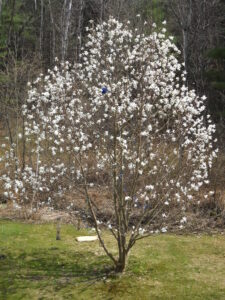
My ‘Merrill magnolia blooms magnificently each April
I also noted that “As insects may have laid their eggs on or in vine crops, tomatoes and potatoes, it is not a good idea to compost these plants.” Diseased or insect-prone plants I recommended for the burn pile or the household trash – or perhaps a pile in a far corner of the property, well away from garden beds. I am happy that our vegetable garden is fully cleaned up and put to bed.
I am grateful for my gardens. My huge ‘Merrill’ magnolia tree that blooms with a thousand white blossoms on my birthday in April. The primrose garden with hundreds of blossoms in the shade of old wild apple trees in June. The peonies that are seemingly everywhere. Milkweed that attracts and nourishes the gorgeous Monarch butterflies. Fall asters, and so many more.
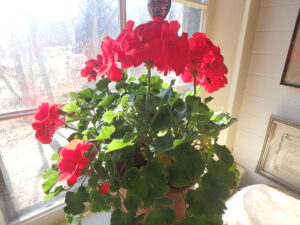
I am grateful for bright red geraniums on my windowsills
Although this may sound silly, I am grateful to have so many potted geraniums in the house. This year we brought in all our geraniums ( Pelargonium spp., not to be confused with perennial geraniums of a different plant family that winters just fine outdoors). They sit on bright windowsills and will bloom off and on all winter, and go outside next summer. Their bright red blossoms give me joy.
I am happy and grateful that I have a small crape myrtle tree in a pot, and have learned how to overwinter it indoors. I bought it in Florida in 2018 and brought it home as carry-on luggage.
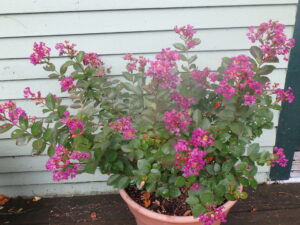
My crape myrtle is a source of joy
Last winter I brought it indoors and overwintered it in our cold, dark basement that stays in the 35 to 50 degree range. I didn’t think it would survive, but it did and bloomed magnificently this summer. The fall foliage was a great red, the leaves dropped, and it has now settled in for its winter rest.

Freezing tomatoes extends the season feeding me even in winter for which I am grateful
I am grateful that we have put up so much food for the coming months. We froze lots of whole tomatoes in zipper bags for use in soups and stews, along with dried cherry tomatoes and some tomato sauce. What else is in the freezer? Lots of leeks, zucchini, kale, Hubbard squash, beets, blueberries and peppers.
I’m happy to have good farm stands nearby. I only had a few peppers this year, so I bought half a bushel from Edgewater Farm in Plainfield, NH at the end of the year. They are great farmers who use the IPM method: Integrated Pest Management. As IPM farmers, they use many of the techniques of organic farmers but reserve the right to use pesticides if a crop is in danger. I prefer to buy organic produce, but trust them to use the least toxic chemicals, and only if necessary. I buy my corn from them and I am always pleased when I get a corn worm: it means that they did not have to spray.
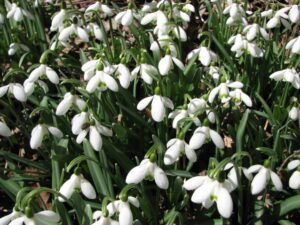
Snowdrops are the first of the bulb flowers to bloom in Spring, and always make me happy when they appear in March
I am happy and grateful that I have been able to plant bulbs each fall for decades. Winters are long here, and the thought of all those little balls of energy waiting in the soil for the onset of spring to come up and share beauty with me makes me happy.
At age 74 I like to point out that I will make it through another winter just because I want to see what else did. I regularly take chances with plants that are not supposed to be hardy in my climatic zone. This year I planted a cut-leaf Japanese red maple, a variety called ’ Tamukeyama’. The cut-leaf varieties are generally less hardy than the standard varieties, of which I have three.
The grower of our Tamukeyama, John Lyon of Newbury, NH (Lyon Family Nursery) told me it is one of the hardiest varieties. We’ll see. I’m happy to have it, and if it does not survive a cold winter, so be it. Although I have never done this before, I will protect it from the wind with a little A-frame shelter made of plywood. I do love the plant.
I am happy and grateful for you, my readers. Each week I get nice e-mails or thoughtful hand-written notes thanking me for sharing my knowledge and sharing personal experiences, and only occasionally disputing my assertions. When my corgi, Daphne, passed away last summer, I was inundated with messages of sympathy. Thank you. Please write to tell me what you are grateful for, where you live, and if I can quote you in a future column.
Lastly, I am grateful that all the newspapers that carry my column are still in business. Subscribe! Buy the paper. Donate to the paper if you get it free. Advertise if you have a business. Local newspapers are the lifeblood of our communities.
Looking Back on 2019
Posted on Monday, December 23, 2019 · Leave a Comment
This past year was, overall, a good one in the garden. It started off cold and wet in early summer, but then turned hot and dry. Most vegetables and perennial flowers did fine for me. I finally splurged and got an Itoh hybrid peony, one called ‘Garden Treasure’ and it bloomed gloriously. It is a cross between a perennial peony and a tree peony.
Carrots and onions, however, were a bust for me this year. Granted I had them in a place where they got more shade than ideal. Still, my carrots were pathetic. Very small. I accept that each year something will under-perform. Fortunately there are good organic farmers who have anything I need. I bought half a bushel of organic onions at the Norwich Farmer’s Market, something I had never needed to do before. Oh well. And good carrots are always available.
My tomatoes did all right. I tried hard to pick off diseased leaves, which always helps. I regularly sprayed an anti-fungal solution called Serenade that contains a bacterium said to combat fungi. I didn’t spray a couple of plants to see if there was a difference, but didn’t notice much difference. It may have delayed the onset of disease, but basically the only way I can get enough tomatoes is to have lots of plants.
Last summer I wrote about a farmer in Pennsylvania who said that staking tomatoes was a waste of time and energy. I said that I would test his theory and report back to you. The results? Staked tomatoes did better for me.
During that dry time in August I installed some drip irrigation in a garden for a client, and found it very helpful for new installations. Gardeners Supply Company (
www.gardeners.com) sells a “Snip and Drip” system that installs easily and delivers water just to the places that need it. I encircled new trees and shrubs with sections of soaker hoses that “leak” when the water is turned on. I found an daily was fine, and used a timer to control it.
Magnolias in my part of the world bloomed deliciously this year. My ‘Merrill’ magnolia bloomed a little late this year, just barely blooming for my birthday in late April, but holding its blossoms well into May. I met a new (to me) magnolia this year, a yellow one called the cucumber tree magnolia (Magnolia acuminata). I am looking for a space to plant one, perhaps this year.
Two years ago I planted a catalpa tree, a 10-foot specimen, in the middle of a section of lawn. I had fallen in love with the blossoms on a neighbor’s tree. The blossoms are creamy white with purple-red stripes inside, and are fragrant. It bloomed after its first winter, but not this past year. But the tree showed no winter kill, and I imagine next summer it will blossom dramatically.
Not all trees bloom every year, and weather has a lot to do with that, I think. So as I nestle in here near the woodstove, I dream of catalpa blossoms in 2020. Maybe gardeners live longer, in part, because we so want to see our plants perform.
Grapes produced huge quantities for most everyone this year. I made over 5 gallons of juice and froze it in half-gallon plastic jugs. I used a NorPro brand “Steamer/Juicer” for this, and it was very easy. The grapes were purple Concord type, and produced juice with a very intense flavor.
Each year it gets harder for me to find space to plant more spring bulbs, but each year I find some. This year we planted 300 or more bulbs at our home here in Cornish Flat. I can’t wait to see them bloom, and to see the others I’ve been planting for decades.
What else happened in 2019? My life partner, Cindy Heath, finally moved in with me in Cornish Flat. We had lived 6 miles apart for the last 10 years, but this May we joined forces here. She is an avid gardener who loves to weed, which really helps a lot! Life is good.
In August I broke a bone in my ankle while pruning a tall apple tree when my ladder slipped off the branch it was on, and I hit the ladder with my ankle when I landed. The fracture was not serious, but it kept me from doing as much as I’d like. It is only now that I am fully healed.
Fortunately, I met and made friends with Jim Spinner, a retired fellow who wanted to learn to garden and who has lots of energy. He helped me a lot, as did Cindy, and by the end of October our gardens were in great shape. I managed to help them despite wearing a big plastic boot much of the time.
And in 2019 two of my good buddies, Jerry Cashion and Brian Steinwand, passed away. I had known them for a total of over 80 years, and miss them a lot. We had all worked in Africa together. But I find that gardening is a fix for almost any sadness. Get out, dig in the dirt, plant a flower or pick a tomato and life seems a little bit better.
I wish you all a wonderful 2020. I hope you will start thinking about the garden now: dream, read gardening books, make lists, and learn about trees or flowers you want to try this coming year. That’s how I make it through the winter.
Planting Trees
Posted on Wednesday, September 17, 2014 · Leave a Comment
Fall is hard upon us, or at least here, in Cornish Flat. I know I should “toughen up” and ignore the cold, but I admit it here: I had my first fire in the wood stove recently. It felt great on a raw, rainy night. “Real” New Englanders never admit to turning on the heat or starting a fire until Halloween or later. Not me. And I’m looking at fall chores outside, too. Chief among them is planting trees and shrubs.
There is disagreement among experts as to the best time to plant trees. Some like spring, saying roots have a longer time to get established before winter. Other say no, if you skip a week or two of watering in the heat of August, you can damage roots or even kill a tree. Fall is safer, they say, because the weather is cooler and often rainy. Experts explain that roots grow and extend in fall, even after leaf drop – right up to the time the ground freezes. That last argument makes sense to me, so I’m in the “plant trees in fall” camp.
Trees sold in nurseries are often grown in fields like corn – row after row of maples, birches and oaks. Then they are lifted out of the soil and plunked into plastic pots. Those pots are then filled up with a potting mix but little or no regard is paid to the placement of the seedling in the pot. Workers don’t seem to know or care that it’s important that the “trunk flare” is on the surface of the potting mix – not buried 3 to 6 inches below the surface. This often causes trouble later on.
I recently planted a 10-foot tall Merrill magnolia for a client. It came in a plastic pot that was about a foot deep and wide. One of the first tasks I did was to dig around in the planting mix to find the trunk flare. Trees in nature – or well planted in the landscape – don’t look like telephone poles at the ground’s surface. Instead, the trunk flares out, displaying above ground “roots” that stabilize the tree in high winds. But even a large tree in a pot may not show much flare.
Here’s the problem: If the flare is covered up, the bark will be covered by soil and will eventually rot. The growing layer beneath it (the cambium) will be ruined – and the tree will decline and die. But it’s a slow process, taking 6 to 10 years. Sometimes more. Look for tip die back – trees that lose their leaves at their tops long before the rest of the leaves. Those are trees that are not doing well, and may have trunk flares covered by soil or mulch. Remove the soil until you can see the trunk flare, and you can save the tree.
At planting time you need to figure out what was above ground while the tree was growing in the ground, and clear soil off it before planting. You might be misled by little roots growing out of the trunk flare if the tree has been in the pot for a year or more. Trees in nurseries are watered from above, so trees in pots grow roots at the surface of the pot. But you can disregard those roots, or cut them off. Use your fingers to loosen soil around the base of the trunk and expose the trunk where it flares out. Then you are ready to plant.
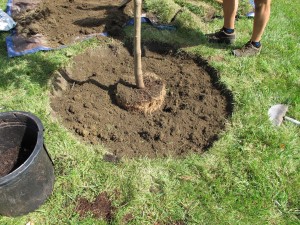
Filling the hole that is wide, not deep
Many experts advise digging a hole that is three times as wide as the pot it came in. I like 4 or 5 times the width of the root ball. The idea is create a zone around the planted tree that has nice loose, fluffy soil that will allow fine roots to penetrate it. But the depth should just be the depth of the root ball, not more. You want the root ball to sit on unexcavated soil so that it doesn’t sink down deeper after a few rains or waterings.
What do you do if planting on a hillside? You must create a level terrace for the tree by cutting into the bank and/or filling up the lower side with fill. Generally it is better to cut into a hillside and re-grade the soil.
Once the hole is dug, remove the tree from the pot and place it in the hole. If you place a tool handle over the hole you can easily see if the hole is the right depth. Be sure the bottom is flat and the tree is vertical, not leaning. Look at it from 2 sides to see if it is straight, and if the best side is showing forward.
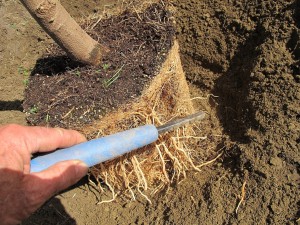
Teasing out the roots
I tease out the roots on the sides and bottom of the root ball to loosen them up before filling the hole. Then I refill the hole, using the same soil I dug out – minus the rocks. It’s okay, according to me, to add a little compost or rich topsoil to the fill if planting in poor soil. But don’t fill the hole just with topsoil and compost. If you do, the roots may never extend past the hole you have dug – like a tree growing in a bathtub.
Mother Nature doesn’t use fertilizer, and I don’t either. I don’t want to push a tree to grow fast in its first year, which fertilizer would promote. I want it to get established, and to send out roots looking for water and minerals.
Planting a tree is not rocket science. Just expose the trunk flare before you put it in the ground, dig a nice wide hole, and keep it watered for the first year of its life. Planted right, your tree should out last you!
Henry Homeyer is a UNH Master Gardener, and the author of 4 gardening books. His e-mail address is henry.homeyer@comcast.net. His Web site is www.Gardening-Guy.com.










